
Aepisaurus was a genus of sauropod dinosaur from the Albian-age Lower Cretaceous Grès vert of Département du Vaucluse, France, around 100.5 million years ago. It is an obscure genus from an unknown family, represented by a single humerus, now partly lost. Despite its lack of popularity, or perhaps because of it, it has been misspelled several ways in the scientific literature, with multiple dates given to the year of description as well.

Ampelosaurus is a titanosaurian sauropod dinosaur from the Late Cretaceous Period of what is now France. Its type species is A. atacis, named by Le Loeuff in 1995. Its remains were found in a level dating from 71.5 million years ago representing the early Maastrichtian.

Betasuchus is a genus of theropod dinosaur which lived during the Late Cretaceous Period. Betasuchus is, besides Orthomerus, the only dinosaur genus named from remains found in the Netherlands and the only non-avian theropod found in the Maastrichtian Beds.

Bradycneme is a genus of theropod dinosaur from the Maastrichtian-age Upper Cretaceous Sânpetru Formation of the Hațeg Basin, Transylvania, Romania. The genus contains a single species, Bradycneme draculae, known only from a partial right lower leg, which its original describers believed came from a giant owl.

Elopteryx is a genus of paravian theropod dinosaur based on fragmentary fossils found in Late Cretaceous rocks of Romania. The single species, Elopteryx nopcsai, was known only from very incomplete material until new specimens were reported in the 21st century. Balaur bondoc might represent a junior synonym of this taxon.

Neosodon was a genus of sauropod dinosaur from the Late Tithonian-age Upper Jurassic Sables et Gres a Trigonia gibbosa of Pas-de-Calais department, France. It has never been formally given a species name, but is often seen as N. praecursor, which actually comes from a different animal. Often in the past, it had been assigned to the wastebasket taxon Pelorosaurus, but restudy has suggested that it could be related to Turiasaurus, a roughly contemporaneous giant Spanish sauropod. It is only known from six teeth.

Variraptor is a dubious and potentially chimaeric genus of dromaeosaurid theropod dinosaur from the Late Cretaceous of France.
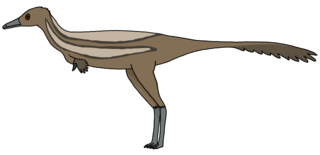
Heptasteornis is the name given to a dubious genus of alvarezsaurid dinosaur from the Late Cretaceous. The type species is Heptasteornis andrewsi, described as a presumed gigantic prehistoric owl in 1975. It was previously included in Elopteryx nopcsai and indeed the holotypes of both were believed to be from the same individual as they were discovered, and initially were assigned the same specimen number. This appears to be in error however.
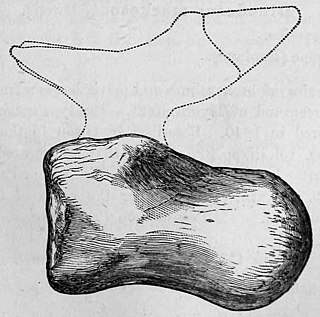
Iuticosaurus is a genus of titanosaur sauropod dinosaur from the Early Cretaceous of the Isle of Wight. Two species have been named: I. valdensis and I. lydekkeri. I. valdensis was found in the Wessex Formation and I. lydekkeri in the younger Upper Greensand.

Lirainosaurus is a genus of titanosaur sauropod which lived in what is now Spain. The type species, Lirainosaurus astibiae, was described by Sanz, Powell, Le Loeuff, Martinez, and Pereda-Suberbiola in 1999. It was a relatively small sauropod, measuring 4 metres (13 ft) long, possibly up to 6 metres (20 ft) long for the largest individuals, and weighed about 2–4 metric tons.
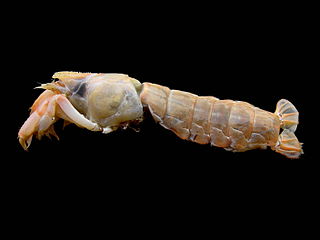
Upogebia is a genus of mud shrimp, in the family Upogebiidae, containing the following species:
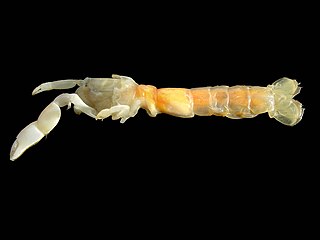
Callianassidae is a family of ghost shrimp crustaceans belonging to the infraorder Axiidea, within the order Decapoda.
Callianassa is a genus of mud shrimps, in the family Callianassidae. Three of the species in this genus have been split off into a new genus, Pestarella, while others such as Callianassa filholi have been moved to Biffarius. The genus is named after the Nereid of the Greco-Roman mythology.

Gilvossius is a genus of thalassinidean crustacean erected in 1992 from former members of the genus Callianassa. It is distinguished from Callianassa by the rounded, rather than squarish telson, and by the absence of the first two pleopods in males. The genus contains the following species:
The Calcaire de Valognes is an Early Jurassic (Hettangian) geologic formation in France. Dinosaur remains diagnostic to the genus level are among the fossils that have been recovered from the formation.
Biffarius is a genus of ghost shrimp in the family Callianassidae, containing species formerly included in the genus Callianassa. Its members are small and generally live in the intertidal zone. In April 2020, a new species was described from the northeastern Brazilian coast. Biffarius was named in honour of Thomas A. Biffar, and includes the following species:
Normanniasaurus is an extinct genus of basal titanosaur sauropod known from the Early Cretaceous Poudingue Ferrugineux of Seine-Maritime, northwestern France.
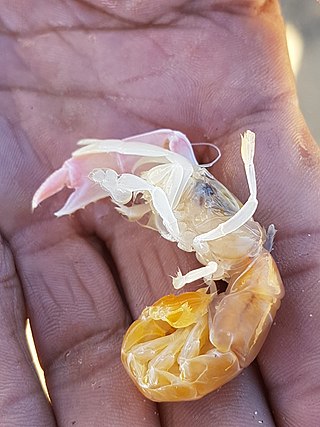
Kraussillichirus kraussi, commonly named the common sandprawn or pink prawn, is a species of ghost shrimp, an African crustacean in the family Callichiridae.
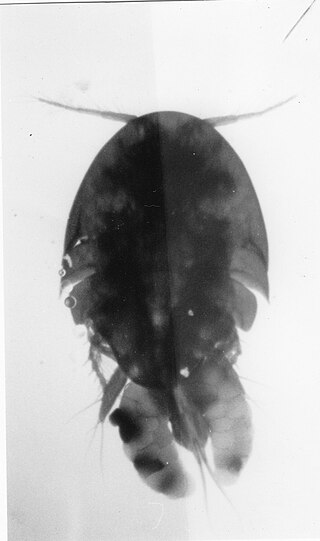
Clausidium dissimile is a species of copepod that has been found along the Atlantic and Gulf Coasts from Massachusetts to Florida. They are found on the bodies of mud shrimp of the family Callianassidae, or from water collected from mud shrimp burrows.

Callichirus major sensu lato is a monophyletic species complex of ghost shrimp in the infraorder Axiidea, found in flat sandy beaches across the Pan-American coastline.















